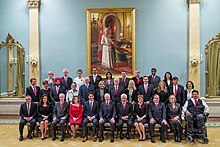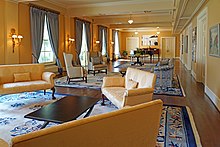Rideau Hall
Officially received at the palace are foreign heads of state, both incoming and outgoing ambassadors and high commissioners to Canada, and Canadian Crown ministers for audiences with either the viceroy or the sovereign, should the latter be in residence.
[15] Even before the building became a viceregal residence, the hall received noted visitors, including three Governors General of the Province of Canada: the Lord Sydenham, the Earl of Elgin, and Sir Edmund Head.
Theo Aronson, in his 1981 biography of Princess Alice, Countess of Athlone, simply stated that the Duke "was found dead on the floor of his room at Rideau Hall on the morning of 26 April 1943.
"[32] The diaries of Sir Alan Lascelles, King George VI's private secretary, published in 2006, recorded that both the regiment and Athlone had rejected him as incompetent,[33] and he fell out of a window when drunk and perished of hypothermia overnight.
Though the resident governor general's wife, Princess Alice, Countess of Athlone, could do little to add her personal touch to Rideau Hall, due to rationing and scarce supplies, she put many of the other royal ladies to work making clothing for those who had lost their homes in the Blitz.
[40] At the end of the global war, the first peacetime ball at Rideau Hall was held for President of the United States Dwight D. Eisenhower, after which life within the household returned to normal.
Churchill, once again Prime Minister of the United Kingdom, returned to Rideau Hall in January of the next year, where, sprawled on a sofa with a cigar in one hand and a brandy in the other, he persuaded Alexander to join the British Cabinet.
The decision to do so was based on concerns expressed by the Royal Canadian Mounted Police and the National Capital Commission for the security of the vicereine and brought Rideau Hall in line with other official residences, including 24 Sussex Drive and Buckingham Palace, that did not allow public access.
[57][58][35] and has a royal and viceregal household to support the sovereign and governor general, comprising a maître d’hôtel, chefs, footmen, valets, dressers, pages, aides-de-camp (drawn from the junior officers of the Canadian Armed Forces), equerries, and others.
Heads of state and government, both incoming and outgoing ambassadors and high commissioners to Canada, and Canadian Crown ministers and loyal opposition leaders are received at Rideau Hall for audiences with either the viceroy or the sovereign,[61][62] should the latter be in residence.
The extension was thus done in an overall Norman style of design that was typical in Quebec at the time, and had a similar long, covered verandah,[9] a cross hall, and a new staircase capped by an ornate stained glass lantern.
[68] In 1872, during the tenure of the Earl of Dufferin, the indoor Tennis Court and the ballroom were added to the western end of the house, arranged to the south and north, respectively, of the main entrance.
[69] Minto's successor, the Earl Grey, added the governor general's study to the far east end of the Monck wing, thus symmetrically balancing out the curved bay and pediment of the original McKay villa to the west.
One of the greatest alterations to the form of Rideau Hall came in 1913, with the construction of the Mappin block as a link between the ballroom and what was then the tennis court (today the tent room), as well as to disguise the misalignment between those two structures.
[70] As such, Chief Dominion Architect David Ewart designed the Mappin block in an "adapted Florentine architectural style",[71] using limestone ashlar, and extended that over the flanking wings by re-facing them and harmonizing their window and cornice heights.
A heavy entablature separates the second and third levels, atop which sits less pronounced pilasters and simply framed windows, with the entire facade capped by a narrow cornice and a pediment with a tympanum that bears a bas relief of the Royal Arms of the United Kingdom (believed to be the largest rendition in the Commonwealth[72]).
[74] The bronze grilles on the doors are formed into a geometric pattern meant to represent infrastructure associated with settlement, including the Canadian Pacific Railway, while circular etching on the glass panels evokes indigenous cultures and the vertical lines echo paintings by Tom Thomson.
[15] Then, at the prompting of Governor General Michaëlle Jean,[15] the main facade of Rideau Hall underwent a major renovation through 2006[15] and 2007, overseen by the National Capital Commission, which has been responsible for the maintenance and upkeep of the building and its grounds since 1986.
As early as the first viceregal inhabitants, the hall has held pieces by prominent Canadian cabinet makers, such as Jaques & Hay of Toronto, James Thompson of Montreal, and William Drum of Quebec.
[82] Until the 1960s, the contents and colours of the house changed with each successive royal and viceregal family; the consort typically seeing it as her duty to update Rideau Hall to suit both her personal and contemporary tastes.
The space, used to greet and host functions for ambassadors and high commissioners to Canada, now contains five carpets donated by the Hongkong and Shanghai Bank and a Steinway & Sons baby grand piano that belonged to Glenn Gould.
"[86] To express the work of the human hand as well as that of machines, the handrail comprises both forged or hand-tooled, fluidly shaped components—the branch-shaped bars, volute brackets, the icy, flowing patterns etched on the narrow art glass panels—with rectilinear, stock, machined-bronze pieces.
Above this is the Victorian, lacunar, clear span vaulted ceiling, from the centre of which hangs a one-ton chandelier, containing 12,000 pieces of Waterford Crystal,[90] that was presented by the British government on Victoria Day in 1951 as a token of gratitude for Canada's role in World War II.
[94] The appearance of the tent room is inspired by the earlier use of striped fabric, draped on the walls and hung in swaths from the ceiling, in order to temporarily transform what was normally the tennis court into a hall for banquets and parties.
[4] On that floor is also a chapel, installed during the Michener period, and which was made ecumenical and opened on 2 July 1967, in the presence of Queen Elizabeth II, for both Anglican and Roman Catholic services.
These moves and removals were criticized by the editorial board of the National Post, as well as other journalists,[n 3] as having "demoted and ghettoized" history in order to "siphon off the great symbolic power of the monarchy, to further [the staff's] particular tastes and agendas," noting that Rideau Hall should not be used "primarily [as] an art gallery.
[114] The last once included a herd of cattle and fields used to grow hay, but today the only remaining agricultural ventures are the vegetable and herb gardens that have been worked since the time of the McKay family.
[117] As with the house that sits on them, the grounds too were transformed throughout the decades: Lady Byng created the existing rock garden, with a reflecting pool and wild corner for growing trilliums and orchids; a totem pole by Kwakiutl carver Mungo Martin was gifted to the Earl Alexander of Tunis by the Lieutenant Governor of British Columbia-in-Council; the Fountain of Hope was initiated by Gerda Hnatyshyn to mark the International Year of Disabled Persons, built in front of Rideau Hall, and dedicated to Terry Fox;[118] and an inukshuk by artist Kananginak Pootoogook, from Cape Dorset, Nunavut, was built to commemorate the second National Aboriginal Day, in 1997.
The earliest governors general added amenities such as a curling rink, a skating pond (which remains in operation, making it one of the oldest rinks in North America[15]), toboggan runs,[n 4] tennis courts, and the like, and many of the guests at Rideau Hall would partake in these outdoor activities, including Prime Ministers William Lyon Mackenzie King and Robert Borden, who would often skate on the iced over pond with the viceregal family.
Of the tobogganing, Lieutenant William Galwey, a member of the survey team that laid out the Canada–United States border and later visited Rideau Hall in November 1871, said: "It is a most favourite amusement at Government House.


















